What is the difference between AC and DC Resistance?
The AC resistance is always more than the DC resistance. Let us understand what is the difference between AC and DC resistance. The resistance of the conductor is inversely proportional to the cross-section area through which the current flows. The AC resistance is more than the DC resistance because the alternating current flowing through the conductor does not distribute uniformly and concentrates near the conductor’s surface; thus, the effective cross-section area decreases, and the resistance increases.
When the DC flows through the conductor, the total cross-section area of the conductor is utilized, and thus, DC resistance is less. AC and DC resistance calculation is important for the selection of the conductors or cables in view of the reduction of line loss.
The following formula expresses the resistance of the conductor.
R= ρL/A
Where,
ρ = Resistivity of the conductor (Ω⋅m)
L = length of the conductor(m)
A = Area of the cross-section of the conductor( Sq.meter)
The resistance of the conductor calculated using the above-given formula is known as the DC resistance of the conductor. The AC resistance of the same conductor is always more than the DC resistance because of the skin effect and proximity effect. A conductor always offers higher resistance to the flow of alternating current compared to the resistance offered when direct current flows through the conductor. The effective cross-section area of the conductor reduces with an increase in the frequency due to the skin effect and proximity effect.
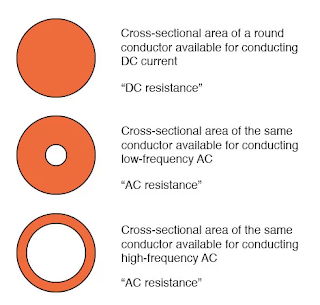
How does resistance increase with AC current?
The tendency of an alternating current to flow near the conductor’s surface is known as the skin effect. As the frequency of the current increases, the current tends to flow at the outer surface of the conductor. The current density is the largest at the outer surface of the conductor. Thus, the effective area of the conductor decreases when alternating current flows in the conductor, and the resistance increases.
The current distribution over the entire cross-section area of the conductor is not uniform when an alternating current flows through the conductor. The current density is higher at the outer surface of the conductor compared to the current density at its center. When the current enters the conductor, it creates a force due to the moving charge, which brings the charges toward the conductor’s surface. The force increases with an increase in frequency.
With an increase in frequency, the charges move at a faster rate at the outer surface of the conductor; the cross-sectional area becomes smaller due to the skin effect, and the effective resistance of the conductor increases. The factors affecting the skin effect are the conductor’s shape, the material’s nature, the conductor’s diameter, and the operating frequency.
Relationship between AC and DC Resistance
When the AC flows in the circuit, the distribution of the current in the conductor depends on the nature of the impedance offered by the current flowing in the conductor. If the circuit is inductive or capacitive, the magnetic field set up with the flow of current will oppose the main current, and thus, it will offer a higher impedance.
The higher frequency current will create a strong Lorentz Force and bring the moving charges to the outer surface of the conductor. The AC resistance of the conductor is always higher than the DC resistance of the conductor. The main reasons for this are the SKIN EFFECT and The PROXIMITY EFFECT.
The mathematical relation between AC and DC resistance is given below.
Rac=Rdc[1+αs+αp]
Where,
Rac = The AC resistance of the conductor
Rdc = The DC resistance of the conductor
αs,αp = Skin effect and Proximity effect factor
How does the SKIN EFFECT increase the AC Resistance?
The AC resistance increases with an increase in the frequency because more charge gets concentrated near the surface of the conductor. As we go from the surface of the conductor to the center of the conductor, the charge concentration decreases and becomes zero at the center of the core. The depth till the charge concentration is available, or the current flows in the conductor, is known as the Skin Depth. The skin depth symbol is δ.
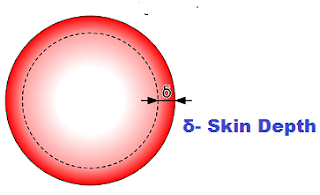
The skin depth decreases with an increase in the frequency for a particular conductor. It depends on the frequency and the resistivity of the material. The skin depth is proportional to the frequency and inversely proportional to the resistivity.
The skin depth of different conducting materials for different frequencies is given below.
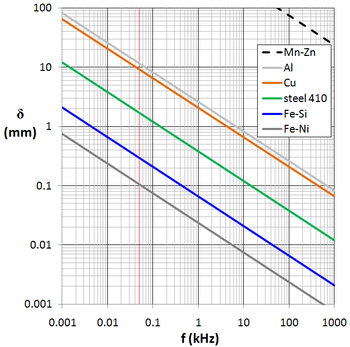
Skin Depth Formula
We can calculate the skin depth using the following mathematical expression. The skin depth formula is as given below.

The skin depth is maximum if the frequency is zero. DC has zero frequency, so the skin depth is maximum, and the total cross-section area of the conductor carries the current; hence, the DC resistance is low. The AC resistance is always higher than the DC resistance. If the skin depth is larger than the radius of the wire, then the AC resistance is equal to the DC resistance.
How Does the proximity Effect increase the AC resistance?
Proximity Effect
When the two nearby conductors carry a current, a magnetic field is set up around the conductors. The flux produced by one conductor gets linked to the other conductor and produces an eddy current around the conductor, which results in an apparent increase in the resistance of the conductor. The phenomenon is known as the PROXIMITY EFFECT.
The current distribution in the conductor changes because of the proximity effect. The current tends to concentrate away from the center of the conductor. This leads to a decrease in the apparent cross-section area of the conductor.
The current distribution in the conductors when the current flows in the same direction is given below.
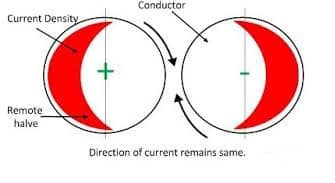
When the current flows in the same direction, it concentrates away from the center of both conductors. Thus, the apparent area of the conductor reduces, and conductor resistance increases. If the frequency of the current is higher, the current tends to concentrate farther from the center, and the resistance of the conductor increases.
The current distribution in the conductors when the current flows in the opposite direction is given below.
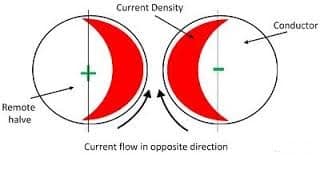
This case has similar effects, but the current concentrates on the adjacent sides of the conductor. However, with this current, the resistance increases because of the reduction in the apparent area of the conductors.
In the case of the DC, the SKIN EFFECT and PROXIMITY EFFECT are totally absent.